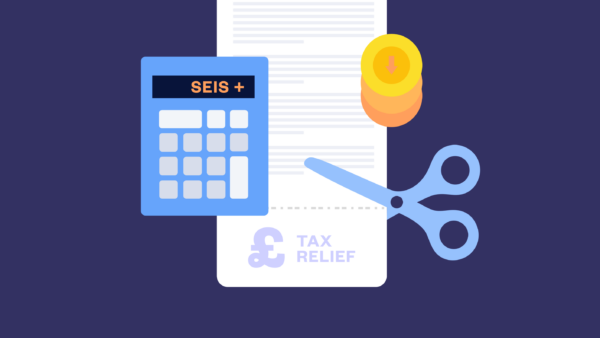SEIS and EIS loss relief: What is it and how can your investors claim it?
Startup not working out? Haven’t been able to raise investment? Here’s how to make sure the SEIS/EIS investors who’ve su...


Thinking of investing in a high-risk startup? Good news – you might be entitled to certain some tax reliefs if you do. The UK government created the Seed Enterprise Investment Scheme (SEIS) to encourage investors to invest in high-risk startups.
When you invest in an SEIS-eligible startup, you can deduct 50% of the amount of your investment from the amount of Income Tax you pay this tax year or last tax year. And you won’t pay Capital Gains Tax on any profits if you hold your shares for at least three years.
In this article, we explain the SEIS benefits and rules so you can better understand whether you could claim tax relief for your investment.
SeedLegals CEO Anthony Rose explains how the Seed Enterprise Investment Scheme can benefit investors:

The SEIS benefits for investors include various types of tax relief. We’ve covered them all below.

For your investment to qualify for SEIS tax relief, you have to adhere to a set of SEIS rules:
1. The company must be eligible
First and foremost, the company you invest in must be eligible for SEIS for you to claim tax benefits. To be eligible for SEIS, a company must meet certain criteria, such as being a UK-based company, having fewer than 25 employees and £350,000 or less in gross assets (read the full criteria in our Guide to SEIS). Make sure you check that the company you’re considering investing in meets these criteria before investing – ask if they have Advance Assurance.
Zlatina TrifonovaAdvance Assurance gives you the security you need to make an investment and know that the company you’re investing in meets the eligibility criteria of the SEIS scheme. This is a very important element of your due diligence – investing in companies without Advance Assurance puts you at risk of not getting the tax relief.
SEIS/EIS Specialist,
2. You must be liable for UK Income Tax
You don’t need to be a UK resident to claim SEIS, but to claim Income Tax relief, you must have income which is liable for UK Income Tax.
3. You can’t be an employee of the company you’re investing in – but you can be a paid director
You and any of your associates must not be an employee of the company between the date the shares are issued until three years later, on the third anniversary of that share issue. However, you can be a director, and receive reasonable compensation for this position. To understand more about this, read SEIS/EIS rules for investor directors.
3. No substantial interest in the company
You must not have any ‘substantial interest’ in the company you’re investing in, at any time from the incorporation of the company until the third anniversary of the date of the share issue.
4. No related investment arrangements
You won’t qualify for SEIS relief if you’ve subscribed for the shares as part of a reciprocal arrangement. For example, if you make an agreement with the owner of Startup A to invest in Startup B through SEIS in exchange for their investment in Startup A, you’d be disqualified from claiming your SEIS relief.
5. No linked loans
No loans should be made to you or your associates which are linked to the company you’re investing in. This applies from the date of incorporation of the company until the third anniversary date of the shares were issued.
Negotiate and sign deals, download your SEIS relief certificates and manage your portfolio - all on one platform.
Learn more
6. No tax avoidance
To be eligible for SEIS relief, an investment must be made for genuine commercial reasons and not as part of a scheme or arrangement intended to avoid tax.
7. Your investment must be less than £200K
From April 2023, you can invest a maximum of £200,000 per year for SEIS in exchange for a 50% tax break and a Capital Gains Tax exemption on any profits you make from the sale of shares after three years. You can carry back your tax relief to the previous year.
8. You must keep the shares for at least three years
If you sell or dispose of your shares in a company before the third anniversary of your share issue, your SEIS relief can be withdrawn or reduced. You must hold your shares for a minimum of three years to receive the full SEIS tax benefits.
9. You must pay for your shares upfront
To receive the full SEIS tax benefits, you must pay for your shares upfront in full and the shares issued must be ordinary shares.
10. You must not receive value from the company for three years
Your SEIS relief could be withdrawn or reduced if you receive value from the company or from a person connected with that company at any time from the incorporation of the company to the third anniversary of the share issue date.
11. No put option or call option for three years
Your SEIS relief could be withdrawn or reduced if there’s a put option or call option over the shares at any time before the third anniversary of the date the shares are issued. Read the definition of put and call options in HMRC’s tax manual.
These are all the SEIS rules for investors. If you still have questions about SEIS rules and benefits for investors, book a call with one of our experts and we’ll get them answered fast.
Want to work smarter and manage your deals seamlessly? We can help you:
Learn more about our tools for investors.
Article Sources
Capital Gain Manual | HMRC – accessed 13 March 2023
Venture Capital Manual | HMRC -accessed 13 March 2023





